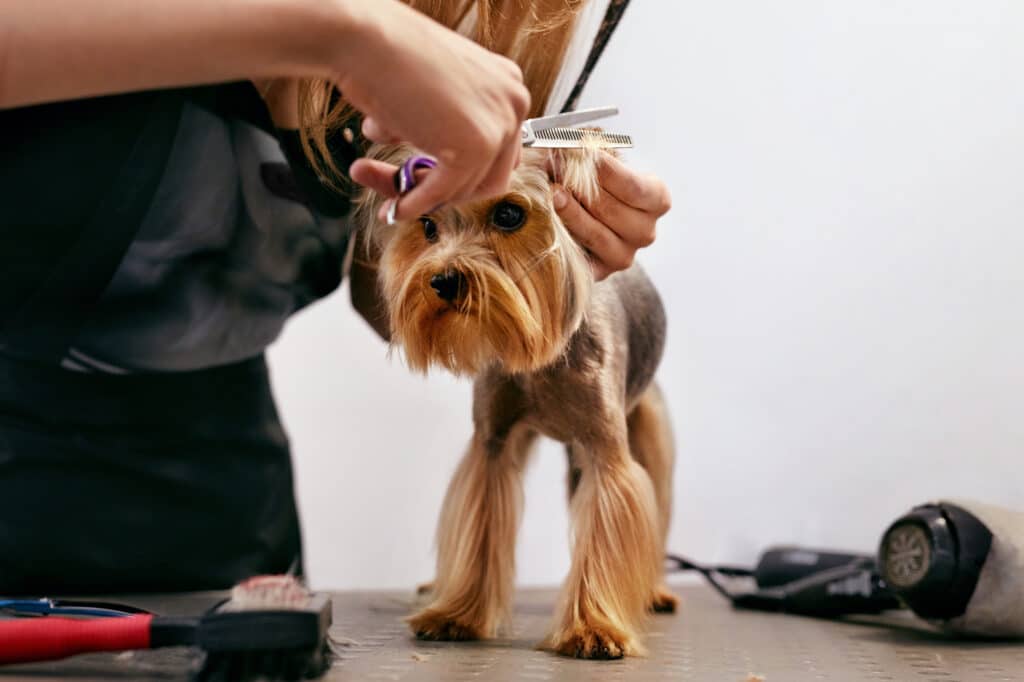
Taking care of a dog involves various responsibilities, including grooming. Dog grooming is not just about maintaining a dog’s appearance but also ensuring their overall health and well-being. One aspect of grooming that often raises questions among pet owners is whether or not they should trim their dog’s ear hair. We will discuss the importance of ear hair maintenance, the risks associated with neglecting it, and safe methods for trimming dog ear hair.
Why is it Important to Maintain Dog Ear Hair?
Dog ear hair plays an essential role in their overall ear health. The hair inside a dog’s ear helps to protect the ear canal from foreign objects like dirt, dust, and insects. It also assists in trapping debris and prevents it from entering the ear canal, potentially causing infections.
Excessive ear hair, on the other hand, can lead to several problems. If the hair becomes too long, it can obstruct the ventilation of the ear canal, creating a warm and moist environment. This environment is ideal for the growth of bacteria and yeast, leading to infections and ear mites. Additionally, overgrown hair can become matted, trapping moisture and exacerbating the problem further.
It is essential to maintain an optimal amount of ear hair to allow proper air circulation while preventing excessive debris from accumulating. Trimming dog ear hair can help achieve this balance.
When Should You Trim Dog Ear Hair?
The frequency of trimming dog ear hair depends on the breed and individual characteristics of your dog. Some breeds are more prone to excessive ear hair growth, such as Poodles, Bichon Frises, Cocker Spaniels, and Schnauzers. Regular trimming may be necessary every few weeks or even monthly for these breeds. In contrast, other breeds with less hair growth or floppy ears may require less frequent trimming.
It’s a good idea to monitor your dog’s ears closely to identify when ear hair maintenance is needed. Look for signs such as excessive shaking of the head, excessive scratching of the ears, redness, swelling, foul odor, or discharge from the ears. These signs may indicate an infection or ear mites and could require immediate veterinary attention.
It is crucial to note that certain breeds, such as the Irish Water Spaniel and Portuguese Water Dog, have ear hair that serves specific purposes and should not be trimmed. If you are unsure about your dog’s breed and their ear hair requirements, consult a professional groomer or veterinarian.
Safe Methods for Trimming Dog Ear Hair
When it comes to trimming dog ear hair, it is crucial to follow safe methods to prevent injury or discomfort for your furry friend. Here are some steps to guide you through the process:
1. Preparation:
Gather the necessary tools, such as small scissors or electric clippers specifically designed for pet grooming. Ensure the tools are clean and sharp to provide a smooth cut and reduce the risk of pulling or tugging on the hair.
2. Calming your dog:
Before starting the grooming session, make sure your dog is calm and relaxed. You can choose to use positive reinforcement or offer treats in order to create a positive association with the grooming process.
3. Visualize the hair:
In a well-lit area, gently hold your dog’s ear flap and use your fingers to expose the hair inside the ear. Examine the hair length and determine the appropriate amount to trim. Be cautious not to pull or cause discomfort to your dog during this process.
4. Trimming technique:
If using scissors, hold them at a downward angle and trim the hair from the top of the ear canal. Only trim the visible hair and avoid going deep into the ear canal to prevent injury. If using clippers, use a comb attachment to ensure a consistent length and gently trim the hair.
5. Take breaks:
Trimming the dog’s ear hair can be a sensitive and potentially uncomfortable process for them. Take frequent breaks during the grooming session to allow your dog to relax and alleviate any stress.
6. Reward and praise:
After completing the grooming session, reward your dog with treats and praise for their good behavior. This positive reinforcement will help create a positive experience for them and make future grooming sessions easier.
Maintaining your dog’s ear hair is an important aspect of their grooming routine. Proper ear hair maintenance ensures optimal ear health and reduces the risk of infections and discomfort. However, it is essential to approach trimming dog ear hair with caution and follow safe methods to prevent injury or discomfort to your furry friend. If you are unsure about how to maintain your dog’s ear hair or if your dog has specific ear hair requirements, consult a professional groomer or veterinarian for guidance. Remember, maintaining your dog’s overall health and well-being should always be a priority.
Other FAQs
Do groomers remove ear hair?
Certain breeds, like poodles and terriers, have hair that grows inside the ear canal. If left unattended, this hair can become matted and, in extreme cases, can lead to infections and other ear-related issues. In such cases, groomers may choose to pluck the excessive ear hair to prevent these problems.
However, not all dogs require their ear hair to be removed. Many breeds, particularly those with floppy ears, do not grow excessive amounts of hair in their ear canals. For these dogs, groomers generally recommend regular ear cleaning to prevent wax buildup and the chance of infections.
It’s important to note that removing ear hair should always be done by a professional groomer or a veterinarian who is skilled in the procedure. Attempting to pluck the hair at home can be extremely uncomfortable for the dog and may cause pain and injury if not done correctly.
Overall, while groomers may remove ear hair for certain breeds, it’s not a universal practice. Regular ear cleaning and proper grooming practices are crucial for maintaining your pet’s ear health, so always consult with a professional to determine the best course of action for your furry friend.
What breeds of dogs need ear hair removal?
One breed that commonly needs ear hair removal is the Cocker Spaniel. With their long, droopy ears, Cocker Spaniels are susceptible to trapping dirt, debris, and moisture in their ear canals. This creates a favorable environment for bacteria and yeast to grow, leading to painful ear infections. Regular ear hair removal helps to keep the ear canals clean and dry, reducing the risk of infection.
Poodles are another breed that often requires ear hair removal. Their dense, curly coats can easily trap hair in their ear canals, which can block airflow and lead to moisture buildup. By removing excess hair, poodle owners can prevent ear infections and promote good ear hygiene.
Other breeds that may benefit from ear hair removal include Bichon Frise, Shih Tzu, Maltese, and Lhasa Apso, as they all have long, luxurious coats that can easily obstruct their ear canals.


